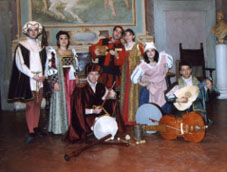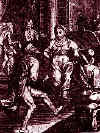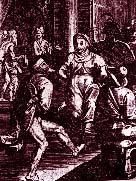

 |
 |
|
|
This ensemble, directed by Paolo Capirci, is composed of actors, singers, recorders, reed-instruments, viols, lyres, lutes, renaissance guitars and percussion.
Its repertoire mainly consists of Italian Renaissance pieces. The intent of this group is to thoroughly go into the existing relationship between the learned repertoire and that of popular inspiration through a performance given in a non-traditional way; it is in fact well-known that the concert-shows frequently held at that time employed the best musicians and actors of the moment.
The patronage of the nobility therefore played an important rule from a historic point of view, allowing the composers to try out the poetic text/music relationship actually on the field, and also that of scenery/music which developed along typical renaissance lines such as Frottole, Madrigals and Villanelle which passed through various intermediaries, then resulted in the late XVIth century experience of the "Camerata de’ Bardi", introduction to baroque melodrama and opera.
"La Mascherata" ensemble wants therefore to evoke particularly these important musical stages, offering them in a form which diverges from the customary way of "making music", trying instead to repropose that which is ad near as possible true to the spirit of Renaissance: music as one of the most significant artistic moments not only but also by inserting it into a vaster context, made up of visual/scenic arts, poetry, theater and other besides.
Having already carried out research and artistic activities for about two years, with the re-discovery of musical treasures (pieces still unedited), the Ensemble La Mascherata made their debut in Umbria in January 1997 with its performance Concerto a Casa Raffaello, dedicated to the music and the environment of Roman culture at the time of pope Leone X; in the summer of that same year it went on several tours both for concerts and performances all over Italy, from Spoleto to the Festival of Anagni, from Lazio to Tuscany, adding to the first production a second one with the title of Come Pulcinella diventa Musico, centred around the Neapolitan country lass in the middle of the XVI century; in the winter of 1998 it performed in L'Aquila (music society "Barattelli"), during the theatrical season of Magione (Perugia), and in Rome (Villa Doria Pamphilj). In July 1998 it made a debut at the "Festival Internazionale di Musica Antica" in Urbino with its new production La Cortegiana Innamorata based on the theatrical idea and music by O. di Lasso e M. Troiano, directed by Antonio Fava. It has made a demo-tape "Villanelle e Mascherate nella Napoli del '500" (Neapolitan Villanelle e Mascherate of the '500s.), with music by G. del Giovane da Nola, P. Cambio, G.T. di Majo, A. Willaert, and anonimous composers. Soon a CD dedicated to music taken from La Cortegiana innamorata is to be made with the Stradivarius recording company.
 |
|